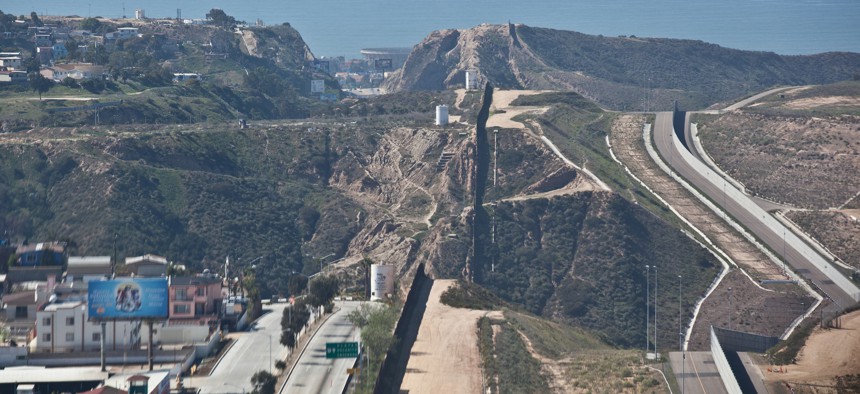
The current fence runs in places along the border, such as this segment near San Diego. Customs and Border Protection file photo
Trump’s Immigration Wall May Have Lethal Consequences
Tightened security at the border is likely to create more dangerous crossing conditions.
Donald Trump wants America to build a permanent wall at the U.S.-Mexico border. "We'll have a great wall. We'll call it the Great Wall of Trump," the real estate mogul toldFox Business recently.
If that ever happens, the consequences could be deadly for the hundreds of thousands of undocumented immigrants who attempt to cross the border each year, many of whom are unlikely to be deterred by even the greatest of walls.
Tightening security at America's southern border will inevitably make it more difficult to illegally traverse. But immigration and security experts warn that any effort to seal off the border will also make conditions more dangerous for the unauthorized immigrants who still try to make it over.
On top of that, the more difficult it becomes to cross the border, the more likely undocumented migrants are to turn to smugglers for help getting across, a cycle that fuels illegal activity and props up networks of organized crime.
"All of this would have unintended consequences," said Rey Koslowski, an expert on border control and homeland security, and a political science professor at the State University of New York at Albany. "As the border becomes increasingly difficult to get over, routes become more dangerous, and if people have money, they will pay even more for someone to get them to the other side."
Trump promises that his immigration agenda "will make America great again." And the platform has won praise in conservative circles. Scott Walker and Ted Cruz, two of Trump's challengers in the 2016 GOP field, have applauded the agenda, with Walker rushing to point out that he also supports a U.S.-Mexico border wall.
The real estate mogul's pledge to overhaul immigration policy devotes a lot of time to talking about how illegal immigration harms American citizens. It does not, however, wade into the impact that Trump's platform is likely to have on undocumented immigrants—a potentially unintended, but very real, consequence of strict border security.
Consider the numbers: Research shows an uptick in migrant deaths at the border in the years following efforts by the U.S. to tighten security and construct fences to keep undocumented immigrants out.
In 2006, the federal Government Accountability Office found that border-crossing deaths doubled after the U.S. ramped up border security in the mid-1990s—even though there did not appear to be a corresponding uptick in undocumented migration during that time.
The University of Arizona published a 2013 report similarly showing that a rise in migrant deaths at the border coincided with stepped up border enforcement and security.
For now, much of the fencing at the U.S.-Mexico border can be found in and around urban areas. That has pushed unauthorized immigrants to traverse the border in far more remote and dangerous places, such as stretches of borderland made up of vast and unforgiving desert.
"With increased enforcement at the border, we have seen a spike of migrants dying in the heat, in the mountains, in the rivers," said Fernando Garcia, the founding director of the Border Network for Human Rights, a nonprofit based in El Paso, Texas and southern New Mexico. "This is a human rights crisis. Hundreds of people are dying at the border."
A permanent wall would ensure that crossing anywhere along the dividing line between the U.S. and Mexico would carry heightened risk. The question then is: What would happen to anyone attempting to cross illegaly who does not turn back as a result?
Advocates for strict border security insist that fencing and U.S. Customs and Border Protection patrols have proven effective. And if a wall were to be built along the entire border, some say that might lessen the incentive that people now have to traverse the most dangerous borderlands.
"If there is no end to the fence then arguably it might be less likely that people would cross in remote desert areas. The reason people cross in places like that is because it's easier to cross, but if you had a fence everywhere that would no longer be true," said Mark Krikorian, the executive director of the Center for Immigration Studies, a think tank that supporters tighter controls on immigration.
Collecting—and drawing precise conclusions from—border crossing statistics is notoriously difficult. But there has been a decline in apprehensions of undocumented immigrants at the southern border in the years since America's border security buildup. Advocates of stricter security point to that statistic as evidence that border controls work. And last year, the number of deaths at the southern border was estimated by the U.S. government at 307, a 15-year record low.
Still, no barrier will ever be high enough or secure enough to completely halt attempts to cross the border illegally. And the more obstacles that stand in the way, the more perilous it will be to cross.
"A wall can slow someone down. It can compel them to change the route they take. But when people want to cross, whatever the motivation is, they will find a way to cross," said Marc Pierini, the former European Union ambassador to Turkey and a visiting scholar at Carnegie Europe.
Available statistics also point to a rise in smuggling as enforcement along the border has tightened, a trend that might intensify if the U.S. builds a permanent border wall.
Data from the Mexican Migration Project, a yearly survey of Mexicans on both sides of the border carried out by Princeton University and the University of Guadalajara, shows a sharp uptick in the share of undocumented immigrants from Mexico that made use of smugglers over the period from 1975 to 2006.
"Many workers from developing regions are willing to … risk their lives to access opportunities in the most affluent countries. Since they cannot do this legally, they often employ organized criminals to assist them, and become more likely to do so as immigration controls tighten," a 2010 report from the United Nations Office on Drugs and Crime concluded.
A report from the Homeland Security Department's Office of Immigration Statistics policy directorate in 2010 suggests that the price that illegal immigrants are willing to pay smugglers has also risen as border enforcement intensified.
The amount of money smugglers can now charge has increased to roughly $3,000 to $6,000, according to 2015 data from the Mexican Migration Field Research and Training Program at the University of California at San Diego.
"The harder it is to get across the border, the more people are willing to pay. Those costs have risen almost in lockstep with the amount of money that the United States spends to secure the border," said John Skrentny, director of the Center for Comparative Immigration Studies at UCSD.
Immigration experts also warn that the more lucrative illegal smuggling becomes, the more incentive there is for organized criminal networks to get involved.
"The conventional wisdom is that smuggling networks have become more professionalized, moving from mom-and-pop organizations to more serious criminal enterprises that have increasingly become intertangled with drug smugglers," said Marc Rosenblum, the deputy director of the U.S. Immigration Policy Program at the nonpartisan Migration Policy Institute.







